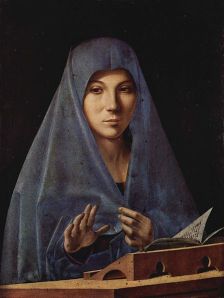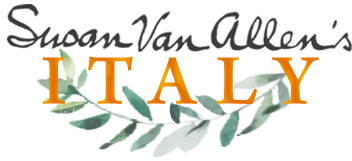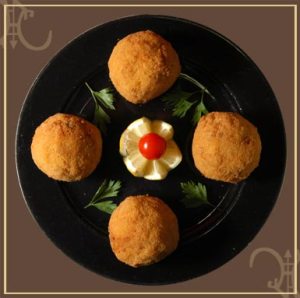 Finally we’ll explore Palermo—the first place many land in Sicily. What struck me about Palermo the first time I visited years ago was the strong Arabic influence that reveals itself in stunning architecture, colorful mosaics, and delicious ornate sweets.
Finally we’ll explore Palermo—the first place many land in Sicily. What struck me about Palermo the first time I visited years ago was the strong Arabic influence that reveals itself in stunning architecture, colorful mosaics, and delicious ornate sweets.
A Golden Day for me in Palermo is exploring La Kalsa, a quiet neighborhood where crumbling baroque buildings, Spanish-Moorish architecture, and artists’ studios blend together in an atmosphere that retains an exotic sense of the Arab port it once was. Take note that Monday is NOT the day for this, as many of the highlights are closed.
 A good place to start is the Palazzo Abatellis, a neo Gothic castle that’s now the Galleria Regionale (Via Alloro 4, Tues-Fri, 9-5:30, Sat-Sun, 9-1). It’s full of Medieval and Renaissance sculptures and paintings. My favorite is this Annunciation by Antonello da Messina. At first I thought it was mistitled…where’s the angel? Renaissance master Messina put the angel offstage, choosing to focus on the reaction of the BVM. With her gorgeous almond-shaped eyes, she resembles the beautiful women of Palermo you’ll see while strolling around.
A good place to start is the Palazzo Abatellis, a neo Gothic castle that’s now the Galleria Regionale (Via Alloro 4, Tues-Fri, 9-5:30, Sat-Sun, 9-1). It’s full of Medieval and Renaissance sculptures and paintings. My favorite is this Annunciation by Antonello da Messina. At first I thought it was mistitled…where’s the angel? Renaissance master Messina put the angel offstage, choosing to focus on the reaction of the BVM. With her gorgeous almond-shaped eyes, she resembles the beautiful women of Palermo you’ll see while strolling around.
 You may stop for coffee at the Parco Letterario di Giuseppe Tomasi di Lampedusa (Vicolo della Neve All’Alloro 2). This is a combination caffe, wine bar, and cultural center, named in honor of the writer Lampedusa, a revered Palermo native, who wrote the classic novel The Leopard. As well as excellent caffe, you can get information here regarding events and touring the area, or even begin a walking tour here.
You may stop for coffee at the Parco Letterario di Giuseppe Tomasi di Lampedusa (Vicolo della Neve All’Alloro 2). This is a combination caffe, wine bar, and cultural center, named in honor of the writer Lampedusa, a revered Palermo native, who wrote the classic novel The Leopard. As well as excellent caffe, you can get information here regarding events and touring the area, or even begin a walking tour here.
Don’t miss the awe-inspiring Santa Maria dello Spasimo,  (Via Santa Maria dello Spasimo 13, daily 8-12)–a 16th century Romanesque church, named “Spasimo” to commemorate Mary’s suffering at the Crucifixion. The church is roofless because a Turkish invasion prevented it from being completed. Two huge sumac trees grow in the middle of what was once (almost) the sanctuary, forming a leafy cupola, opening to the Palermo sky. It’s a lovely place to sit and relax and you’re likely to hear rehearsals going on in the attached music school that was once a monk’s cloister. For a truly magical experience, get there for one of their evening concerts—info at www.thebrassgroup.it.
(Via Santa Maria dello Spasimo 13, daily 8-12)–a 16th century Romanesque church, named “Spasimo” to commemorate Mary’s suffering at the Crucifixion. The church is roofless because a Turkish invasion prevented it from being completed. Two huge sumac trees grow in the middle of what was once (almost) the sanctuary, forming a leafy cupola, opening to the Palermo sky. It’s a lovely place to sit and relax and you’re likely to hear rehearsals going on in the attached music school that was once a monk’s cloister. For a truly magical experience, get there for one of their evening concerts—info at www.thebrassgroup.it.
Lunch at Antica Focacceria San Franceesco (Via A. Paternostro 58, 091 320 264, closed Mon). This family run institution that’s been around since 1834 is a wonderful spot for the best of Sicilian specialties, such as arancini (stuffed rice balls), Pasta con Sarde (with sardines) or La Fantasia degli Involtini (a mixed plate of rolled up sardines, eggplant, swordfish, and meat–each stuffed with the classic combo of breadcrumbs, raisins, and pine nuts).
 In the afternoon you can get a glimpse of 19th century Sicilian artistocratic life with a visit to the baroque Palazzo Mirto (Tues-Sat 9-5:30, Sun, 9-1). I love imagining the great parties that must have gone on here in these ornate rooms, particularly in the Chinese salon.
In the afternoon you can get a glimpse of 19th century Sicilian artistocratic life with a visit to the baroque Palazzo Mirto (Tues-Sat 9-5:30, Sun, 9-1). I love imagining the great parties that must have gone on here in these ornate rooms, particularly in the Chinese salon.
A favorite Palermo restaurant of mine for dinner, closer to the core of the historic center is Sant’Andrea (Piazza Sant’Andrea, Closed Sun, dinner only, reservations advised: 091 334999). The seafood pastas here are beloved.
 I like staying at the Massimo Plaza Hotel, a simple, elegant, reasonably priced place across from the Teatro Massimo (Opera House)–as seen in Godfather III. Check the Teatro Massimo website before you arrive to get tickets for an opera or concert when in season (closed in August), or work in an afternoon tour of the theatre while you’re there.
I like staying at the Massimo Plaza Hotel, a simple, elegant, reasonably priced place across from the Teatro Massimo (Opera House)–as seen in Godfather III. Check the Teatro Massimo website before you arrive to get tickets for an opera or concert when in season (closed in August), or work in an afternoon tour of the theatre while you’re there.
For more luxurious digs, check out the Grand Hotel et des Palmes (Via Roma 398)—or at least stop into their jewel-box of a bar for a cocktail while you’re in Palermo.





I would love to go back to Palermo.